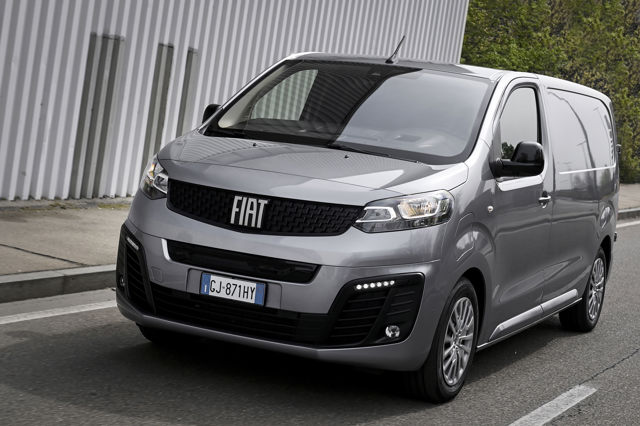Fiat Scudo (2022 – 2024) Review
Fiat Scudo (2022 – 2024) At A Glance
The Fiat Scudo isn’t the first van from the Italian brand to share its body and running gear with the Vauxhall Vivaro, but the latest generation of the mid-size van is a very different beast to its predecessor thanks to Fiat becoming part of the Stellantis Group. Read our full Fiat Scudo review to find out if it’s the ideal van for you.
The third-generation Fiat Scudo came along in 2022, reusing a name form the past to replace the slow-selling Fiat Talento, which was created as part of a joint venture with Renault and Opel-Vauxhall. Like Vauxhall, Fiat was absorbed into the Stellantis Group in 2021, so yet again Fiat’s mid-sizer is essentially the same van as that offered by Vauxhall and that’s a very good thing.
Using the same body and engines as the Vauxhall Vivaro, as well as the Peugeot Expert, Citroen Dispatch and Toyota Proace, the Fiat Scudo is part of a range of vans that is among the most prolific across Europe and beyond.
Sold under the Fiat Professional banner, the Fiat Scudo is sold mostly to fleet customers but that doesn’t mean you should discount it – if you can get one for a better price than its sister models, there’s very little to choose between them and all of them are excellent vans.
It’s based on what Stellantis calls its EMP2 platform, available in two lengths and with 1.5 or 2.0-litre diesel engines. An electric Fiat e-Scudo is also offered and is reviewed separately.
The entry 1.5-litre diesel is offered with either 100PS or 120PS engines and a six-speed manual gearbox, while the 145PS 2.0-litre adds the option of eight-speed automatic transmission as well as a flagship (but rare) 180PS model that is auto only.
Two trim levels are offered – the reasonably equipped and no-nonsense titled ‘Standard’ and the more upmarket ‘Primo’, with standard (5.0 metre) and Maxi (5.3 metre) body lengths, with both getting a double cab crew van option and the longer van getting standard twin side loading doors. All come with a 36-month, 100,000-mile warranty.
Driving the Fiat Scudo (2022 – 2024)
Whichever engine you go for, a core part of the Fiat Scudo’s appeal lies in its car-like dynamics. All models have adaptive variable damping shock absorbers, which vary the damping with the vehicle's ride height making it far less crashy over bumps than some vans tend to be when unladen.
Go for the Primo model and you also get extended safety kit, including speed limit recognition, lane departure warning, Side Blind Spot Alert and Driver Attention Alert systems.
The four-cylinder turbodiesel engines are punchy enough even in lower powered forms. The 100PS and 120PS 1.5-litre Multijet engines are fine for everyday use, though the lower-powered model is stretched with a heavy load on board. The 145PS 2.0-litre Multijet is a terrific all-rounder and the 180PS auto-only model is perfect for long, high-speed journeys which are utterly effortless.
Manual models have a six-speed transmission which is effortlessly easy to use, while the eight-speed auto is superb. Fuel economy is pretty decent, ranging from 45.8 to 51.4mpg on the WLTP test cycle.
All manual models have a 2.5-tonne towing capacity, with the autos rated at 2.2 tonnes. There is also a “Grip Control” system, which manages the traction control so you can choose between five driving modes: Asphalt, Snow, Sand, Mud, and ESP OFF.
It’s a great overall van – ideal for anyone seeking out a capacious mid-size van that’s usefully smaller than its rivals in urban use – but core to its appeal will be its price. Sister models from Vauxhall, Citroen, Peugeot and Toyota are absolute equals, so the model you choose should come down to the best deal you can get. Bear in mind, too, that Fiat’s three-year, 100,000-mile warranty isn’t as good as Vauxhall’s or Toyota’s.
Fiat Scudo (2022 – 2024) interior
Despite its modest dimensions - the Fiat Scudo is quite small for a mid-sized van – there’s no questioning the model’s ability when it comes to carrying loads. It’ll carry between 1100kg and 1400kg in payload, the short wheelbase, two-seater model having the highest rating thanks to its lighter body weight.
There are two body lengths – standard and Maxi – with load volumes ranging from 5.1 cubic metres to 6.6 cubic metres. An optional load-through bulkhead also extends the load length of the van up to four metres, if ordered alongside the folding double passenger seat.
It’s available in just one roof height giving access of 1.4 metres in height and 1.6 metres in width, but the load bay is flat and wheelarch intrusion is minimal, while the rear axle is far enough back and the side doors wide enough to allow wider loads to be mounted closer to the bulkhead.
The cabin is car-like and comfortable, with seats that appear hard-wearing and logically laid-out controls.
Three-seater models add extra functionality as well, with the centre seat folding down to double up as table, while there is a useful storage compartment under the middle seat to hide valuables such as small power tools and laptop computers.
The raised seating position provides a great view of the road, but rear visibility isn’t great and the mirrors could use a bit more all-round visibility, especially on the Standard trim model, which is bereft of a rear-view camera.








:no_upscale():format(webp)/https://cdn.uk.prod.group-mobility-trader.com/images/cas/3bf28ec0d38bcbdea69049fb7cd6b5ff/69e625d4568a97fb797c91f64ae8b30e.jpg)

 Great to drive, good safety kit, impressive payload
Great to drive, good safety kit, impressive payload
 Warranty could be better, rear visibility not great
Warranty could be better, rear visibility not great
:no_upscale():format(webp)/https://cdn.uk.prod.group-mobility-trader.com/images/cas/6dbaf0c504da3481c66a6f6012caaa50/f2b48071375769021d38f4a91fbdee03.jpg)
:no_upscale():format(webp)/https://cdn.uk.prod.group-mobility-trader.com/images/cas/b4de1791441dd299e67010b1068f48b7/91988d206436ba88bef151de052d1e9e.jpg)
:no_upscale():format(webp)/https://cdn.uk.prod.group-mobility-trader.com/images/cas/03fe7719d3fea2b68fc3a28e7667aa5f/b21cbbc4176efd8a9dce8d85d662469e.jpg)